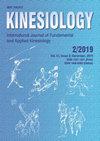SOKOL: BETWEEN MAKING NATION AND STATE
IF 0.9
4区 医学
Q4 REHABILITATION
引用次数: 2
Abstract
The Sokol gymnastic movement was an important part of civil societies of Slavic nations. The first Sokol society within Yugoslavian nations (Slovenes, Croats, Serbs) was founded in 1863 in Ljubljana and in a few decades, it spread throughout the Slovene, Croatian, and Serbian territories. In the Austro-Hungarian period before WWI, Sokol valued itself as a national, liberal and emancipation-seeking movement, based on the Tyrsch’s gymnastics and national and pan-Slavic idea. In 1919, following the end of WWI and with the formation of the Yugoslav state, the national Sokol organisations merged in the centralised Yugoslav Sokol Union. The Yugoslavian state went through difficult political situations and confrontations in the first decade, which culminated in the summer of 1928 with shooting in the parliament in Belgrade. In attempting to solve the situation, King Aleksandar Karadjordjevic proclaimed the so-called Sixth January Dictatorship (1929). Consequently, the government, with the approval of the King, adopted, on the 4th of December 1929, the law on establishing of a new all-state gymnastic organisation Sokol of the Kingdom of Yugoslavia. Thenew Sokol organisation, based on the Sokolism of the former Yugoslav Sokol (Sokol’s gymnastics, principles, national-liberal and Slavic idea) was constituted at the beginning of 1930. It was supported by the King and government and the King’s son, Prince Petar became the leader of the Sokol organisation. After the assassination of king Aleksandar (1934), in the filling-in period of Prince Pavle (1935-41) and government of the Prime Minister Milan Stojadinovic (1935-39), Sokol of the Kingdom of Yugoslavia fell out of political grace in the western Roman-Catholic regions and it had to defend its position. Due to drasticall changes in international policy (German revisionist policy, the “Anschluss” in 1938 and the Czechoslovakian crisis in 1938/39), more militaristic practices were included in the Sokol’s professional work to preserve a free and independent state. During tense diplomatic events in March 1941, when Yugoslavia entered the Nazi-Fascist camp, Sokol supported a military putsch and stepped into the front lines of demonstrations. In that mood, Sokol faced the Nazi-Fascist attack on Yugoslavia in April 1941 and the beginning of WWII in theYugoslav territory. Key words: Sokol movement, gymnastic movement, South Slavs (Slovenes, Croats, Serbs), Kingdom of Yugoslavia, Austro-Hungary索科尔:在创造民族和国家之间
索科尔体操运动是斯拉夫民族民间社会的重要组成部分。南斯拉夫民族(斯洛文尼亚人、克罗地亚人、塞尔维亚人)的第一个索科尔社会于1863年在卢布尔雅那成立,几十年后,它遍布斯洛文尼亚、克罗地亚和塞尔维亚领土。在第一次世界大战前的奥匈帝国时期,索科尔将自己视为一个民族、自由和寻求解放的运动,其基础是泰尔施的体操以及民族和泛斯拉夫思想。1919年,第一次世界大战结束后,南斯拉夫国家成立,国家索科尔组织合并为中央集权的南斯拉夫索科尔联盟。南斯拉夫国家在最初的十年里经历了艰难的政治局势和对抗,1928年夏天贝尔格莱德议会发生枪击案,达到了顶峰。为了解决这一问题,国王亚历山大·卡拉乔尔杰维奇宣布了所谓的1月6日独裁统治(1929年)。因此,政府在国王的批准下,于1929年12月4日通过了关于成立新的南斯拉夫王国索科尔国家体操组织的法律。新的索科尔组织成立于1930年初,以前南斯拉夫索科尔的索科尔主义(索科尔的体操、原则、民族自由主义和斯拉夫思想)为基础。它得到了国王和政府的支持,国王的儿子佩塔王子成为了索科尔组织的领导人。亚历山大国王遇刺(1934年)后,在帕夫勒亲王(1935-41年)和总理米兰·斯托贾季诺维奇(1935-39年)的政府任职期间,南斯拉夫王国的索科尔在罗马天主教西部地区失宠,不得不捍卫自己的地位。由于国际政策的急剧变化(德国的修正主义政策、1938年的“安什卢斯”和1938/39年的捷克斯洛伐克危机),索科尔在维护自由和独立国家的专业工作中加入了更多的军国主义做法。1941年3月,当南斯拉夫进入纳粹法西斯阵营时,在紧张的外交事件中,索科尔支持了一场军事政变,并走上了示威的前线。在这种情绪下,索科尔于1941年4月面临纳粹法西斯对南斯拉夫的袭击,并在南斯拉夫领土上开始了第二次世界大战。关键词:索科尔运动、体操运动、南斯拉夫人(斯洛文尼亚人、克罗地亚人、塞尔维亚人)、南斯拉夫王国、奥匈帝国
本文章由计算机程序翻译,如有差异,请以英文原文为准。
求助全文
约1分钟内获得全文
求助全文
来源期刊

Kinesiology
REHABILITATION-SPORT SCIENCES
CiteScore
1.90
自引率
8.30%
发文量
16
审稿时长
>12 weeks
期刊介绍:
Kinesiology – International Journal of Fundamental and Applied Kinesiology (print ISSN 1331- 1441, online ISSN 1848-638X) publishes twice a year scientific papers and other written material from kinesiology (a scientific discipline which investigates art and science of human movement; in the meaning and scope close to the idiom “sport sciences”) and other adjacent human sciences focused on sport and exercise, primarily from anthropology (biological and cultural alike), medicine, sociology, psychology, natural sciences and mathematics applied to sport in its broadest sense, history, and others. Contributions of high scientific interest, including also results of theoretical analyses and their practical application in physical education, sport, physical recreation and kinesitherapy, are accepted for publication. The following sections define the scope of the journal: Sport and sports activities, Physical education, Recreation/leisure, Kinesiological anthropology, Training methods, Biology of sport and exercise, Sports medicine and physiology of sport, Biomechanics, History of sport and Book reviews with news.
 求助内容:
求助内容: 应助结果提醒方式:
应助结果提醒方式:


